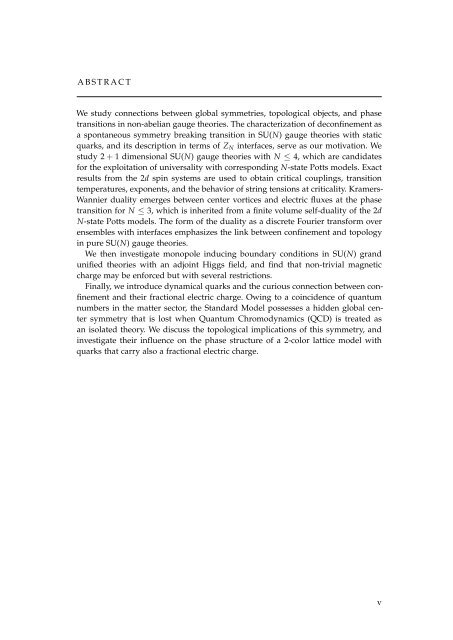Topology, symmetry, and phase transitions in lattice gauge ... - tuprints
Topology, symmetry, and phase transitions in lattice gauge ... - tuprints
Topology, symmetry, and phase transitions in lattice gauge ... - tuprints
Create successful ePaper yourself
Turn your PDF publications into a flip-book with our unique Google optimized e-Paper software.
A B S T R A C T<br />
We study connections between global symmetries, topological objects, <strong>and</strong> <strong>phase</strong><br />
<strong>transitions</strong> <strong>in</strong> non-abelian <strong>gauge</strong> theories. The characterization of deconf<strong>in</strong>ement as<br />
a spontaneous <strong>symmetry</strong> break<strong>in</strong>g transition <strong>in</strong> SU(N) <strong>gauge</strong> theories with static<br />
quarks, <strong>and</strong> its description <strong>in</strong> terms of Z N <strong>in</strong>terfaces, serve as our motivation. We<br />
study 2 + 1 dimensional SU(N) <strong>gauge</strong> theories with N ≤ 4, which are c<strong>and</strong>idates<br />
for the exploitation of universality with correspond<strong>in</strong>g N-state Potts models. Exact<br />
results from the 2d sp<strong>in</strong> systems are used to obta<strong>in</strong> critical coupl<strong>in</strong>gs, transition<br />
temperatures, exponents, <strong>and</strong> the behavior of str<strong>in</strong>g tensions at criticality. Kramers-<br />
Wannier duality emerges between center vortices <strong>and</strong> electric fluxes at the <strong>phase</strong><br />
transition for N ≤ 3, which is <strong>in</strong>herited from a f<strong>in</strong>ite volume self-duality of the 2d<br />
N-state Potts models. The form of the duality as a discrete Fourier transform over<br />
ensembles with <strong>in</strong>terfaces emphasizes the l<strong>in</strong>k between conf<strong>in</strong>ement <strong>and</strong> topology<br />
<strong>in</strong> pure SU(N) <strong>gauge</strong> theories.<br />
We then <strong>in</strong>vestigate monopole <strong>in</strong>duc<strong>in</strong>g boundary conditions <strong>in</strong> SU(N) gr<strong>and</strong><br />
unified theories with an adjo<strong>in</strong>t Higgs field, <strong>and</strong> f<strong>in</strong>d that non-trivial magnetic<br />
charge may be enforced but with several restrictions.<br />
F<strong>in</strong>ally, we <strong>in</strong>troduce dynamical quarks <strong>and</strong> the curious connection between conf<strong>in</strong>ement<br />
<strong>and</strong> their fractional electric charge. Ow<strong>in</strong>g to a co<strong>in</strong>cidence of quantum<br />
numbers <strong>in</strong> the matter sector, the St<strong>and</strong>ard Model possesses a hidden global center<br />
<strong>symmetry</strong> that is lost when Quantum Chromodynamics (QCD) is treated as<br />
an isolated theory. We discuss the topological implications of this <strong>symmetry</strong>, <strong>and</strong><br />
<strong>in</strong>vestigate their <strong>in</strong>fluence on the <strong>phase</strong> structure of a 2-color <strong>lattice</strong> model with<br />
quarks that carry also a fractional electric charge.<br />
v
















